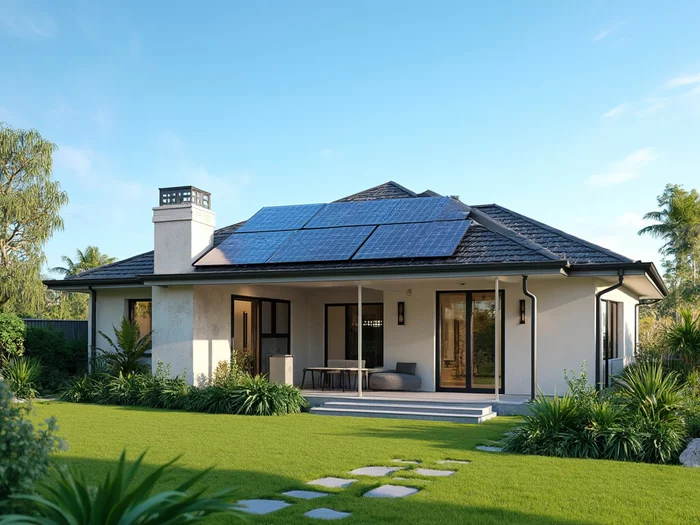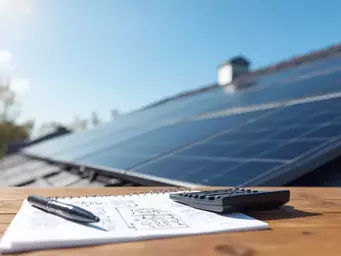Efficiency Ratings Overview
Understanding how well each panel type converts sunlight into electricity.
Unlock expert insights on solar panel installation, energy savings, and government rebates for Australian homes and businesses. Join our community of informed solar enthusiasts!
Posted on: 2025-10-11
By: Evelyn Tran
Choosing solar panels can be daunting, especially with so many options available. But understanding your choices can transform your energy consumption and savings. Let’s uncover the essential insights to guide your solar journey.
This visual compares the three main types of solar panels—Monocrystalline, Polycrystalline, and Thin-Film—based on their efficiency ratings and key characteristics.
Understanding how well each panel type converts sunlight into electricity.
Choosing the right solar panel for your home can feel overwhelming, but I'm here to help you navigate the options! It’s crucial to understand the different types of solar panels available, their efficiencies, and how they can impact your energy savings. At Longi Solar Solutions, we believe that informed choices lead to smarter investments in solar energy.
In this section, we’ll explore various solar panel types, compare their efficiencies, and discuss how these technologies can fit into Australian homes. Let’s dive into the details!
When it comes to solar panel technology, you generally have three main types to choose from: monocrystalline, polycrystalline, and thin-film. Each type has its unique features and benefits that might suit your home’s specific requirements. For more general information on going solar, you can refer to this Homeowner's Guide to Going Solar.
By understanding these types, you can make a more informed decision based on your energy needs and financial goals.
So, which type should you choose? It ultimately depends on your specific circumstances. If you have limited roof space and want the highest efficiency possible, monocrystalline panels are the way to go. They excel in terms of performance and aesthetics!
On the other hand, if you're looking to save on upfront costs and have ample space on your roof, polycrystalline panels might be a better fit. They're an excellent choice for cost-effective installations without compromising too much on efficiency.
Thin-film solar panels offer some unique advantages, particularly in specific Australian climates. Their lightweight nature allows for easier installation, and they perform better in high temperatures compared to crystalline panels. However, one downside is that they usually require more space to produce the same amount of energy, which might not be ideal for all homeowners.
Before deciding, consider the following pros and cons of thin-film panels:
Efficiency ratings play a significant role in determining how much energy your solar panels can generate. In Australia, it’s essential to choose panels that not only fit your budget but also deliver reliable performance year-round. Understanding these ratings can help you maximize your energy savings!
Keep in mind that higher efficiency means more energy output for the same amount of sunlight, which can significantly impact your overall savings in the long run. The performance and reliability of photovoltaic systems are crucial considerations, as detailed in research findings on photovoltaic module materials and technology.
The efficiency rating of a solar panel indicates how well it converts sunlight into usable electricity. For example, a panel with a rating of 20% can convert 20% of the sunlight it receives. Generally, the higher the efficiency, the more energy you can generate, which can lead to greater savings on your electricity bills.
To put things in perspective, here are some typical efficiency ratings:
Let’s look at some real-life scenarios! Homeowners across Australia have reported significant energy savings after switching to solar. For instance, a family in Melbourne installed monocrystalline panels and noticed a 50% reduction in their energy bills within the first year!
These case studies highlight the potential of solar energy to positively impact your finances while also benefiting the environment. At Longi Solar Solutions, we’re committed to sharing these success stories to inspire others to go solar!
When evaluating solar panels, consider these key metrics beyond just efficiency ratings:
By focusing on these metrics, you can ensure that you select a solar system that meets your needs and offers long-term reliability. For further insights into buying reliability and maintenance, consider resources like the American Solar Energy Society's guide on solar performance.
When selecting solar panels, consider the long-term impact of efficiency ratings. A higher efficiency panel may cost more upfront but can lead to greater savings on your energy bills over time. Always assess your roof space and energy needs to determine the best fit for you!
As you navigate your options for solar panels, it’s crucial to stay focused on the essential factors that will lead you to make an informed decision. Choosing the right system for your home is not just about technology; it’s about understanding your unique needs, budget, and environmental conditions. At Longi Solar Solutions, we believe that empowering homeowners with the right information is key to a successful transition to renewable energy.
Here are some key takeaways to keep in mind during your solar panel buying journey:
By reflecting on these points, you can make educated choices that align with both your financial goals and energy needs.
So, what’s next? Making the leap to solar energy might seem daunting, but breaking it down into manageable steps can simplify the process. I recommend starting with a consultation with a qualified solar expert who can provide tailored advice based on your specific situation.
These steps will not only give you clarity but also help you feel confident in your choice to go solar. Remember, the journey to renewable energy is a partnership, and I’m here to help guide you along the way!
Here is a quick recap of the important points discussed in the article:

 Ready to unlock the potential of solar energy for your home? Understanding the financial landscape o
Ready to unlock the potential of solar energy for your home? Understanding the financial landscape o
 As you contemplate the shift to solar energy, consider this: a comprehensive understanding of the co
As you contemplate the shift to solar energy, consider this: a comprehensive understanding of the co
 Choosing the right solar installer can significantly impact your renewable energy journey. Are you r
Choosing the right solar installer can significantly impact your renewable energy journey. Are you r